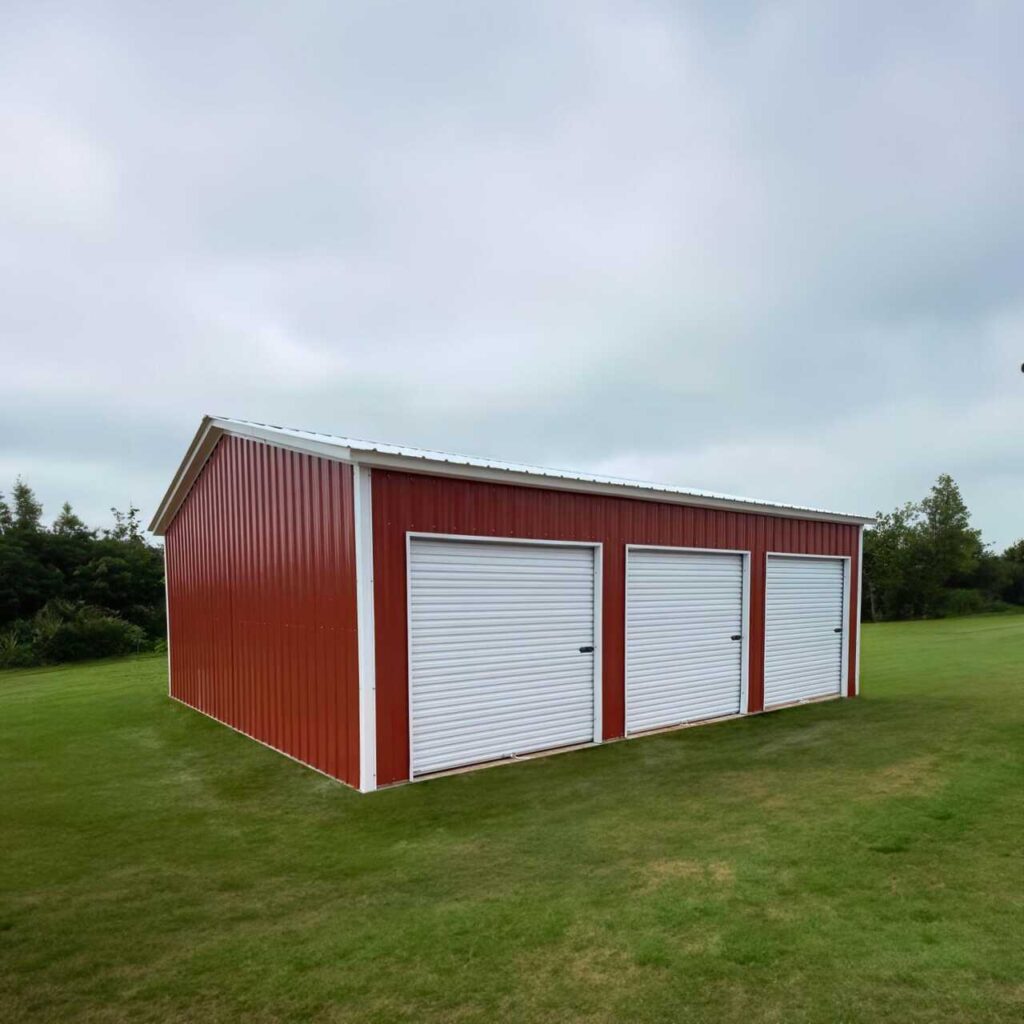
Contents
When aiming to maximize the energy efficiency of your custom metal structures, it’s crucial to take into account a few key factors that can make a significant impact on sustainability and operational costs. By implementing strategic design elements and incorporating cutting-edge technologies, you can gain access to substantial benefits beyond mere functionality. Stay tuned to discover how these top tips can transform the way you approach energy efficiency in your custom metal structures.
Key Takeaways
- Optimize building orientation for sunlight efficiency.
- Choose effective insulation materials for thermal control.
- Implement LED lighting and intelligent controls for energy savings.
- Ensure proper ventilation and airflow design.
- Consider solar panels and green roofs for sustainable energy generation.
Building Orientation for Sunlight Efficiency
To maximize sunlight efficiency in energy-efficient custom metal structures, consider orienting the building to take advantage of natural light sources throughout the day. Sunlight exposure plays an essential role in the energy consumption of a building. By strategically placing windows and designing the structure to minimize shading, you can enhance the use of natural light.
When planning the orientation of your custom metal structure, take into account the path of the sun during different seasons. This will help you determine the best placement for windows to allow for maximum sunlight exposure while minimizing heat gain.
Furthermore, window placement is key to ensuring proper sunlight penetration. By placing windows strategically, you can improve natural lighting and reduce the need for artificial lighting during the day. Additionally, consider the use of reflective materials on surfaces such as roofs or walls to redirect sunlight into darker areas of the building.
Reflection can help illuminate spaces that are typically shadowed, further reducing the reliance on artificial lighting sources.
Insulation Selection and Installation
When selecting insulation for your custom metal structure, it’s vital to think about effective insulation materials and proper installation techniques.
The appropriate insulation material can greatly influence the energy efficiency of your building. Employing proper installation methods ensures maximum performance and durability of the insulation system.
Effective Insulation Materials
Selecting and installing appropriate insulation materials is necessary for ensuring energy efficiency in custom metal structures. When it comes to effective insulation materials, reflective coatings play an essential role in minimizing heat transfer. Reflective coatings, such as aluminum foil or metallic paints, can help reduce radiant heat gain, keeping the interior of the structure cooler in hot climates.
To combat thermal bridging, which can lead to energy loss, consider incorporating radiant barriers into the insulation system. Radiant barriers, typically made of reflective materials like aluminum foil, are designed to reflect heat away from the structure, reducing the amount of heat that penetrates through the insulation.
Proper Installation Techniques
Consider the specific thermal conductance and thickness requirements of the insulation materials to ensure proper installation techniques for maximizing energy efficiency in custom metal structures.
When installing insulation in custom metal structures, it’s essential to ensure a proper foundation for the insulation. The insulation should be firmly anchored to prevent gaps or movement that can compromise its effectiveness.
To start, evaluate the thermal conductance of the chosen insulation material to determine its ability to resist heat flow. Thicker insulation is generally more effective at reducing heat transfer. Proper installation involves fitting the insulation tightly against the metal structure without compression, ensuring consistent coverage without leaving any gaps.
When securing the insulation, use appropriate methods such as clips, straps, or adhesive to optimize it stays in place. Proper anchoring prevents the insulation from sagging or shifting over time.
Energy-Efficient Lighting Solutions
Implementing energy-saving lighting solutions is crucial to enhancing energy consumption in customized metal structures. Efficient lighting diminishes electricity expenses and contributes to a more eco-friendly environment. Here are some tips for energy-saving lighting solutions customized for customized metal structures:
Utilize Intelligent Controls:
Intelligent controls, such as occupancy sensors and programmable timers, can enhance lighting usage by automatically adjusting light levels based on occupancy and natural light availability. These controls ensure that lights are illuminated only when necessary, minimizing energy wastage.Incorporate Daylight Harvesting:
Daylight harvesting systems utilize sensors to detect natural light levels and adapt artificial lighting accordingly. By integrating daylight harvesting into your customized metal structure, you can capitalize on natural light, reducing the requirement for artificial lighting during daylight hours.Upgrade to LED Lighting:
LED lighting is highly energy-efficient and long-lasting in comparison to traditional incandescent or fluorescent lights. By switching to LED fixtures, you can notably diminish energy consumption and maintenance costs in your customized metal structure.
Proper Ventilation and Airflow Design
When designing your custom metal structure, it’s important to think about effective airflow placement and ventilation system optimization. Proper ventilation and airflow design can greatly impact the energy efficiency of your building.
Effective Airflow Placement
How can proper ventilation and airflow design enhance the energy efficiency of custom metal structures? Effective airflow placement plays an important role in optimizing energy consumption and maintaining a comfortable environment within the structure.
Airflow balance: Achieving a balance between the intake and exhaust airflow is essential to prevent air stagnation and maintain a consistent temperature throughout the structure. Strategic placement of vents and ducts can help achieve this equilibrium.
Ventilation efficiency: Efficient ventilation systems enhance indoor air quality and contribute to energy savings. By directing airflow in the most effective manner, ventilation efficiency can be maximized, reducing the load on heating and cooling systems.
Airflow direction: Controlling the direction of airflow is key to regulating heat distribution and moisture levels within the structure. Proper airflow direction ensures that cool air is distributed where needed while warm, moisture-laden air is effectively removed.
Ventilation System Optimization
Optimizing the ventilation system through proper design and airflow management is fundamental for enhancing the energy efficiency of custom metal structures. When considering ductwork design, it’s pivotal to minimize air leakage and ensure efficient airflow distribution throughout the structure.
By incorporating energy recovery systems within the ventilation setup, such as heat exchangers, you can leverage the thermal energy present in the outgoing air to precondition the incoming fresh air, reducing the overall energy demand for heating or cooling.
Incorporating natural ventilation strategies can further improve the energy efficiency of custom metal structures. By strategically placing operable windows, louvers, or vents, you can encourage passive airflow and decrease the dependence on mechanical ventilation systems.
Additionally, integrating heat recovery units into the ventilation system allows for the extraction of heat from the exhaust air and its transfer to the incoming fresh air stream, minimizing energy wastage and optimizing thermal comfort within the structure.
Proper ventilation design and airflow management are essential components in achieving energy efficiency and creating an environmentally friendly environment within custom metal structures.
Utilizing Solar Panels and Green Roofs
Incorporating solar panels and green roofs into custom metal structures enhances their energy efficiency and durability. When considering energy-efficient custom metal structures, utilizing solar panels and green roofs can greatly reduce the overall environmental impact and operational costs.
Here are three key benefits of integrating solar panels and green roofs into your custom metal structure:
Renewable Energy Generation: Solar panels harness the power of the sun to generate electricity, reducing the dependence on conventional energy sources. By capturing solar energy, these panels can help power various systems within the structure, contributing to a more sustainable operation.
Green Roof Benefits: Green roofs provide insulation, reduce heating and cooling costs, and offer environmental advantages like improved air quality, reduced stormwater runoff, and enhanced biodiversity. Incorporating eco-friendly landscaping practices with green roofs further amplifies these advantages.
Rainwater Harvesting: Green roofs can also facilitate rainwater harvesting, where the collected water can be used for irrigation or other non-potable purposes. This eco-conscious practice helps conserve water resources and reduces the pressure on municipal water supplies.
Maintenance Practices for Energy Savings
Implementing regular upkeep practices is necessary for maximizing energy savings in customized metal structures. Focusing on key areas such as roof upkeep and window sealing ensures that your building remains energy-efficient over time.
Upkeep Practices for Energy Savings
To keep your customized metal structure running efficiently, it is vital to pay attention to the following upkeep practices:
| Upkeep Task | Description | Frequency |
|---|---|---|
| Roof Upkeep | Regularly examine and mend any | Every 6 months |
| harm to the roof to avert leaks | ||
| Window Sealing | Inspect for openings and fissures in window | Annually |
| seals and weatherstripping for | ||
| enhancing insulation efficiency |
Roof upkeep involves checking for loose or damaged panels, making sure of proper insulation, and clearing any debris that may accumulate. By addressing these issues promptly, you can prevent energy loss through the roof.
Similarly, window sealing plays an important role in maintaining energy efficiency. Well-sealed windows help prevent air leaks, reducing the burden on heating and cooling systems. Regularly inspecting and mending window seals can lead to significant energy savings in the long run. Remember, a well-maintained customized metal structure is more energy-efficient and environmentally friendly in the long term.
Wrap-Up
You can achieve maximum sustainability and cost savings by incorporating the top tips for energy-efficient custom metal structures.
Imagine a building that harnesses the sun’s power, breathes efficiently, and glows with efficient lighting – a masterpiece of energy efficiency.
By carefully considering building orientation, insulation, lighting, ventilation, and renewable energy sources, you can create a custom metal structure that’s both environmentally friendly and a beacon of innovation in the construction industry.
Recent Posts
Benefits of Using Metal in Construction Projects
Isn’t it fascinating how a simple material can transform the landscape of construction? When you
What Are the Benefits of Durable Metal Construction?
While traditional building materials may offer charm, they often fall short in durability compared to
Benefits of Choosing Strong Metal for Construction
When it comes to bolstering your construction projects, opting for strong metal for construction can




